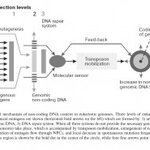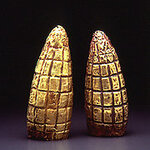Genetics & Molecular Biology

“You gotta know when to hold ‘em. Know when to fold ‘em.” It’s an old adage that every experienced poker player knows. The main goal is to play the game successfully and maximize your profits. But what if that game is life, and cruel, impersonal genetics is the dealer? There is no luxury of folding your hand and waiting for the next one. People with genetic diseases need to find a way to play the hand that they’re dealt. Fortunately, new scientific research is helping explain the rules of the game, especially for the genetic disease…

One of the most common hypotheses that I hear with regard to possible non-coding DNA function is that it serves to protect genes against mutation. Junk DNA, according to this proposal, is there to provide a defensive shield against mutagens (usually this includes UV, ionizing radiation, chemical mutagens, viruses, and/or oxygen radicals). I am very skeptical of this explanation, but I am willing to take it seriously if it is studied seriously. In fact, one of my current graduate students first came to talk with me when he was an undergraduate and asked me about this possible function. For his…

Today's issue of Molecular Cell has two complementary papers on biological signal processing that look interesting (subscription required):
"The Incoherent Feedforward Loop Can Provide Fold-Change Detection in Gene Regulation":
Many sensory systems (e.g., vision and hearing) show a response that is proportional to the fold-change in the stimulus relative to the background, a feature related to Weber's Law. Recent experiments suggest such a fold-change detection feature in signaling systems in cells: a response that depends on the fold-change in the input signal, and not on its absolute level…

Q.1 (i) A yeast artificial chromosome (short YAC) is a vector used to clone large DNA fragments (larger than 100 kb and up to 3000 kb). It is an artificially constructed chromosome and contains the telomeric, centromeric, and replication origin sequences needed for replication and preservation in yeast cells. Built using an initial circular plasmid, they are linearised by using restriction enzymes, and then DNA ligase can add a sequence or gene of interest within the linear molecule by the use of cohesive ends. They were first described in 1983 by Murray & Szostak.
(ii) Recombinant DNA is…

Molecular biologists and mathematical models frequently don't mix well, especially when the molecular biologists in question were trained before the rise of genomics, back when most labs only needed a computer for designing new vector sequences, writing papers, and checking email. Behind this skepticism is the intuition that biology is extremely messy (true), and difficult to quantify (also true). Also contributing is the long history of the cell as a molecular black box; for a long time, we had no idea what was going on inside the cell in molecular terms (somewhat analogous to doing…

Dear Mickey - How is life? Life is tough, says my friend. Do you agree? I wanted to write to you for a number of reasons. Believe it or not, people still remember that you turned 80 last year: Happy Eighties to you, M-I-C-K-E-Y!
You are shy in public. That is OK because people would prefer a shy mouse any day. Research related to shyness concentrates on humans at this time. Someday someone will report on your kind of shyness, I am certain. You are also a big mouse! Are you up for some mice news? The latest find is hormonal on/off switch for male mice fertility. Michele…

Abnormally high levels of P-cadherin – an adhesion molecule that enables cells to bind together – occur in about a third of all breast cancers and are associated with poor prognosis. Portuguese researchers , writing in the journal Oncogene1, found that the reason why these cancers are more aggressive is because excessive P-cadherin changes the cancer cells’ internal organization, making them mobile and invasive (invasiveness is the capacity to cross biological barriers such as membranes). Both these characteristics allow the formation of metastases - which is the spread of cancer cells…

Men could soon have the same control over their fertility that women have had since the 1960s, according to a new paper published in the December 2009 issue of The FASEB Journal. The authors of the paper say they have found how and where androgenic hormones work in the testis to control normal sperm production and male fertility.
The discovery was the result of studies performed in two groups of mice. The first group of mice was normal, but the second was missing a gene from the peritubular myoid cells in the testis. This missing gene codes for the androgen hormone receptor, and when missing…

Before you eat that next slice of pecan pie or second serving of mashed potatoes at Christmas dinner this year, you may want to think twice; those extra helpings could be even worse for your waistline than previously thought.
A new research report appearing online in The FASEB Journal suggests that a diet high in fat and sugar actually switches on genes that ultimately cause our bodies to store too much fat. This means these foods hit you with a double-whammy as the already difficult task of converting high-fat and high-sugar foods to energy is made even harder because these foods also…

Gold maize was made by the ancient people of Peru, like the Moche Culture, because they ate corn. Corn, or maize (Zea mays L.) among scientists, is now one of our planet's top crops. It is both food for billions of people and livestock and feedstock for biofuels and other products. Scientists, having sequenced already other plants such as rice, sorghum, poplar, grape, and Arabidopsis thaliana, have recently developed the Maize (Corn) Genome for future applications.
"Sequencing the corn genome will help researchers in the United…